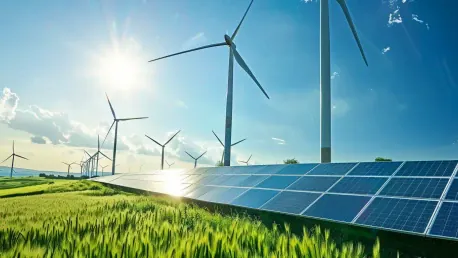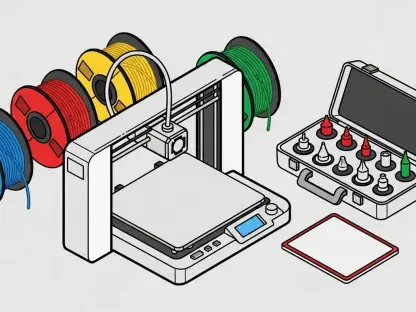Over recent years, the United States has witnessed a notable revitalization in its manufacturing sector, with a strong emphasis on green energy and semiconductors. This resurgence can be attributed to a combination of strategic trade policies, generous tax incentives, and an array of federal support programs. These initiatives are designed to minimize the nation’s dependency on foreign suppliers, particularly from China, and to stimulate domestic economic growth. The concerted drive towards self-reliance has reshaped the landscape of US manufacturing, creating a fertile ground for innovation and investment.
Strategic Trade Policies
The US government has undertaken decisive measures to secure its domestic supply chain, particularly focusing on the solar and semiconductor industries. Robust trade restrictions, including tariffs on Chinese green energy components, have been enforced through the Trade Acts of 1974 and 2005. Such policies aim to counteract unfair trade practices and fortify domestic industries against foreign competition. This strategic maneuver enables the US to build a more resilient and self-reliant industrial base.
Section 301 tariffs have been imposed on imported Chinese components, significantly increasing their costs. By January 2025, solar modules, solar cells, polysilicon, wafers, and semiconductors were subjected to a 50 percent tariff, while battery parts encountered a 25 percent tariff. Additionally, Section 201 tariffs targeted Chinese solar energy equipment, with rates escalating to 14 percent by February 2026. These measures aim to nullify any cost advantages enjoyed by Chinese suppliers due to lower production costs and forced labor practices.
The Uyghur Forced Labor Prevention Act further underscores the commitment to ethical trade practices. This act has focused on curbing imports tied to forced labor and has led to the detention of suspect solar panels. Additionally, new industry standards have been established to ensure compliance with ethical sourcing and production methods. These policies collectively contribute to building a transparent and fair trade environment, thereby supporting domestic manufacturers.
Federal Tax Incentives
Federal tax credits have emerged as pivotal tools in bolstering domestic manufacturing capabilities, especially within the green energy sector. The Inflation Reduction Act (IRA) and the CHIPS Act are instrumental in offering considerable incentives aimed at promoting the production of renewable energy technologies within the US. These legislative measures have created a conducive atmosphere for both new and existing manufacturers.
The IRA introduces a 10 percent domestic content bonus for projects that utilize US-made components. This bonus applies to wind, solar, battery, and other renewable technologies, encouraging the adoption of locally produced parts. Furthermore, Section 45X manufacturing production tax credits under the IRA incentivize the production of eligible solar, wind, and battery components, enhancing the domestic supply chain.
The CHIPS Act plays a crucial role in revitalizing the semiconductor manufacturing sector by providing the advanced manufacturing investment credit (Section 48D). This credit offers a substantial 25 percent for investments in semiconductor manufacturing facilities. These tax incentives ensure that domestic manufacturers can invest in state-of-the-art technologies, fostering innovation and maintaining a competitive edge in the global market.
Federal Loans, Loan Guarantees, and Grant Programs
To further support clean energy manufacturing projects, the US government provides low-interest loans, loan guarantees, and grants through various federal agencies. These financial aids serve as alternative financing routes for projects that may struggle to secure traditional loans. The availability of such options significantly reduces the financial barriers that often hinder the initiation and completion of large-scale manufacturing projects.
The Department of Energy’s Loan Programs Office (LPO) has notably expanded its authority and, as of September 2024, financed projects valued at $43.9 billion. This substantial investment highlights the federal commitment to advancing clean energy manufacturing. Additionally, the CHIPS Program Office (CPO) has announced significant grant awards and loans to support semiconductor manufacturing. By January 2025, the CPO had awarded $32.5 billion in grants and $5.5 billion in loans. These funds facilitate the establishment and expansion of semiconductor manufacturing facilities in the US.
Such financial support mechanisms are crucial in de-risking the investment landscape for clean energy and semiconductor projects. They ensure that domestic manufacturers have access to the necessary capital to scale operations, adopt new technologies, and enhance production capacities. These initiatives contribute to the overall growth of the green energy sector by enabling more projects to reach completion stages.
Growth in US Manufacturing Capacity
The United States has experienced an unprecedented surge in green energy manufacturing projects over the past two years. An impressive 303 new projects have been announced, leading to a quadrupling of investments to $89 billion and a significant boost in construction spending. This surge has positioned the US as the third-largest solar module producer globally, underscoring the nation’s growing influence in the green energy domain.
There are comprehensive plans to further expand production capabilities. Solar cell production is projected to increase by 56GW, wafer production by 24GW, and ingots production by 13GW. These expansions are vital in fulfilling both domestic and international demand for renewable energy components. The Department of Commerce projects that by 2032, the US will be manufacturing 30 percent of the world’s leading-edge chips, a testament to the country’s growing manufacturing capacity and its commitment to leading the global market.
This growth translates into substantial economic benefits, including job creation and enhanced local economies. It also reinforces the country’s ability to meet its renewable energy targets, contributing to global sustainability efforts. The comprehensive expansion plans reflect a strategic vision that prioritizes long-term growth and sustainability in the green energy sector.
Investment Trends and Project Financial Structures
As of September 2024, 20 of the largest manufacturing projects initiated since August 2022 were slated for completion by 2028, with more than half expected to finish by the end of 2026. These projects have been meticulously planned to ensure on-time and on-budget completion. They employ a mix of equity, debt, and federal incentives, with the value of federal income tax credits playing a crucial role in their financial structures.
To mitigate construction and operational risks, developers typically favor fixed-price construction contracts. These contracts help secure cost certainty and prevent budget overruns. Additionally, securing supply agreements for raw materials and entering long-term offtake arrangements with reliable buyers ensure financial stability and smoother project execution. These strategies provide a robust framework for the successful development of large-scale manufacturing projects.
The financial structure of these projects reflects a keen understanding of the risks and opportunities involved in the green energy sector. By leveraging a mix of funding sources and adopting prudent risk management strategies, developers can navigate the complexities of the industry and ensure the successful realization of their manufacturing ambitions.
Navigating Political Risks
In recent years, the United States has experienced a significant revival in its manufacturing sector, with a major focus on green energy and semiconductors. This revival stems from a blend of strategic trade policies, substantial tax incentives, and a variety of federal support programs. These measures aim to reduce the nation’s reliance on foreign suppliers, particularly from China, and to promote domestic economic growth. The push towards self-sufficiency has transformed the U.S. manufacturing landscape, paving the way for innovation and investment.
The emphasis on green energy reflects a global shift towards sustainable production methods, gaining the U.S. both economic and environmental advantages. Investments in semiconductor technology bolster the country’s position in a critical industry with broad applications in technology, defense, and everyday consumer products.
In addition to direct economic benefits, these changes also create high-skilled jobs, helping to revitalize communities that were once heavily reliant on manufacturing. The combination of these factors fosters a robust, resilient national economy capable of weathering global disruptions.
Overall, the strategic focus on green energy and semiconductors, coupled with targeted policies and support, is spearheading a new era for American manufacturing. This forward-thinking approach ensures that the United States remains competitive on the global stage while addressing critical economic and environmental concerns.









